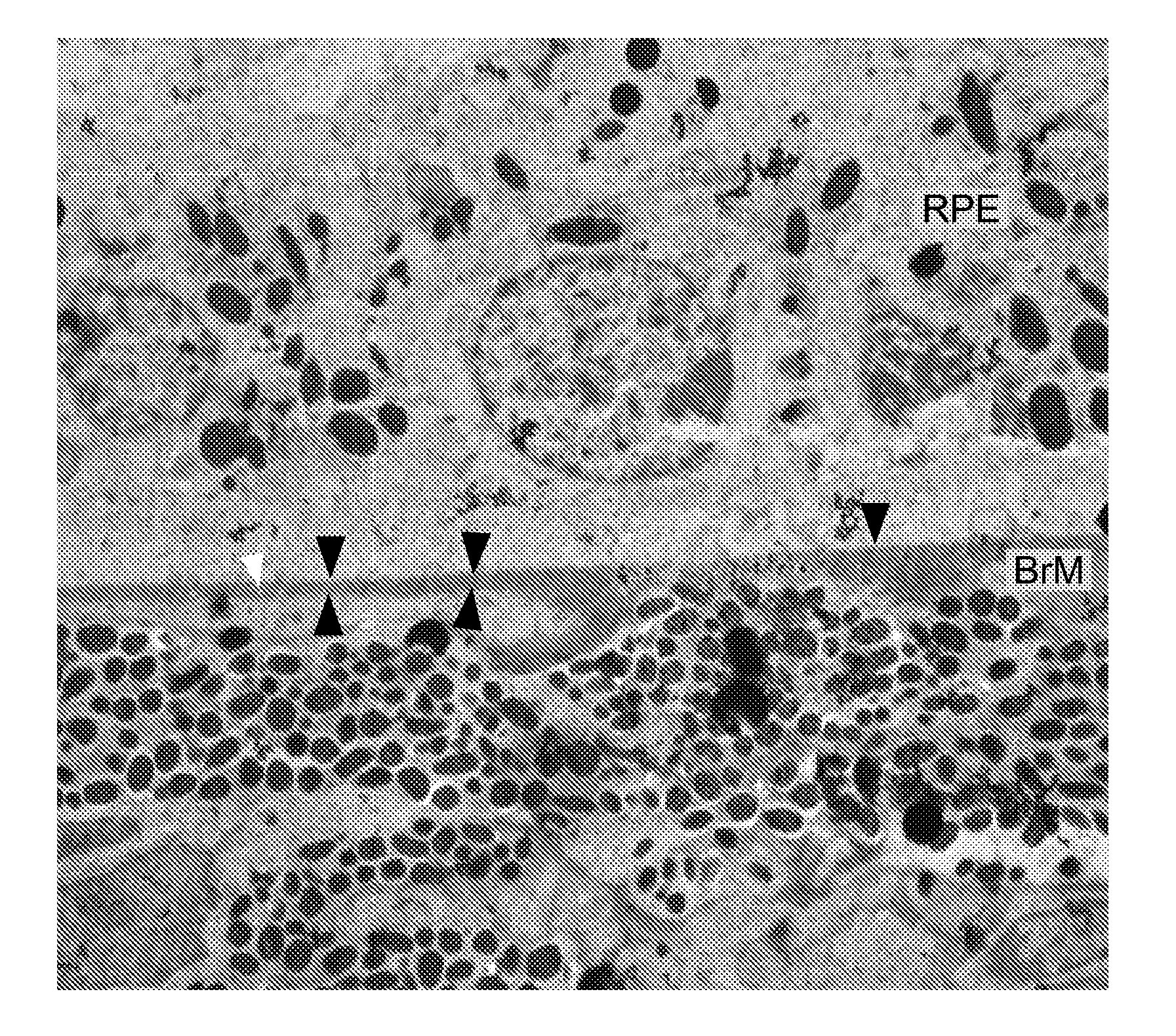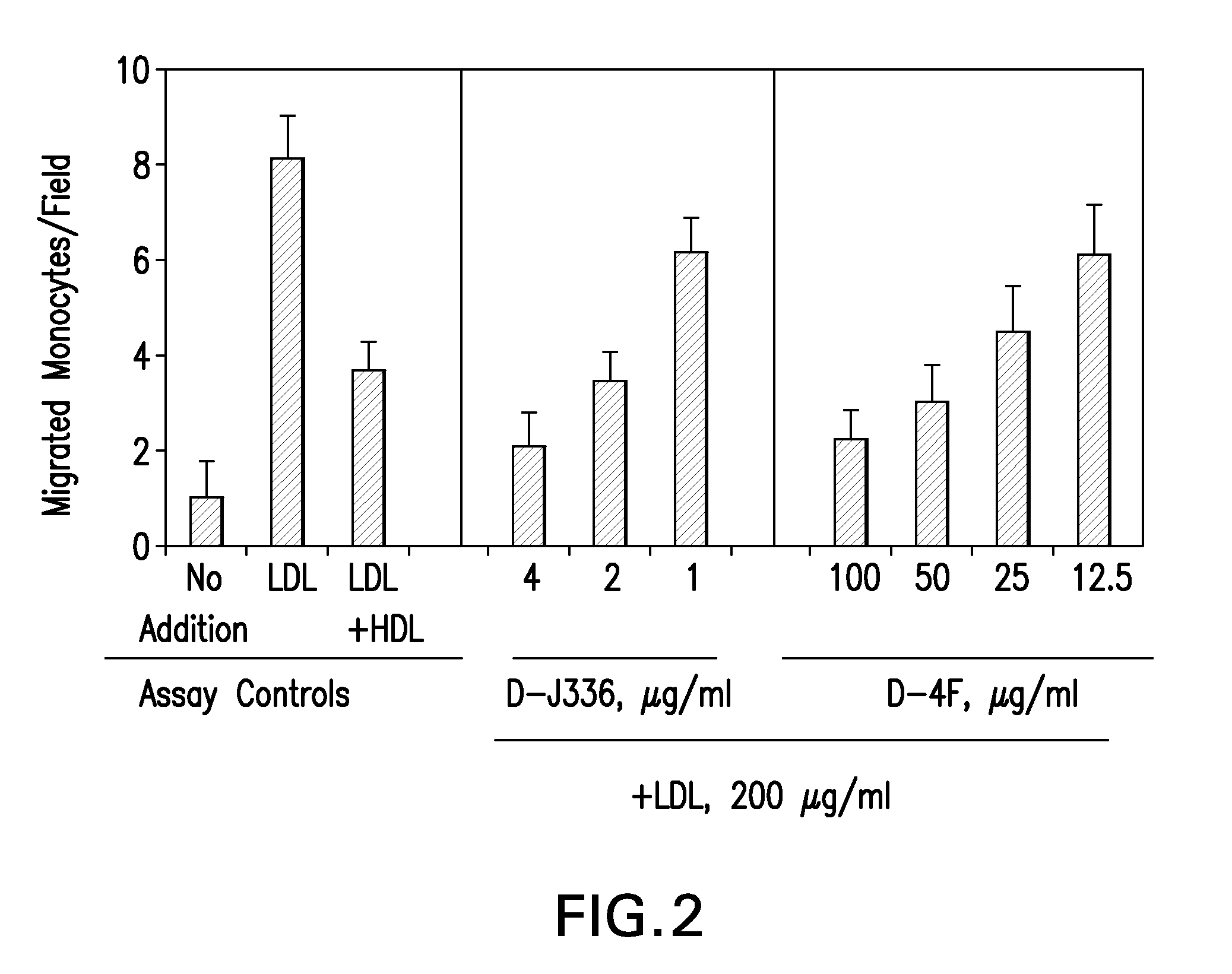Peptides and peptide mimetics to treat pathologies associated with eye disease
a technology of pathologies and peptides, applied in the field of atherosclerosis, can solve problems such as death and disability, affecting the quality of life, and affecting the ability to recognize faces and day-to-day tasks, and achieve the effects of reducing the risk of death and disability, and reducing the risk of eye diseas
- Summary
- Abstract
- Description
- Claims
- Application Information
AI Technical Summary
Benefits of technology
Problems solved by technology
Method used
Image
Examples
example 1
Use of ApoJ-Related Peptides to Mediate Symptoms of Atherosclerosis
Prevention of LDL-Induced Monocyte Chemotactic Activity
[0360]FIG. 1 illustrates a comparison of the effect of D-4F (Anantharamaiah et al. (2002) Circulation, 105: 290-292) with the effect of an apoJ peptide made from D amino acids (D-J336, Ac-L-L-E-Q-L-N-E-Q-F-N-W-V-S-R-L-A-N-L-T-Q-G-E-NH2, SEQ ID NO:1177)) on the prevention of LDL-induced monocyte chemotactic activity in vitro in a co-incubation. Human aortic endothelial cells were incubated with medium alone (no addition), with control human LDL (200 μg protein / ml) or control human LDL+ control human HDL (350 μg HDL protein / ml). D-J336 or D-4F was added to other wells in a concentration range as indicated plus control human LDL (200 μg protein / ml). Following overnight incubation, the supernatants were assayed for monocyte chemotactic activity. As shown in FIG. 1, the in vitro concentration of the apoJ variant peptide that prevents LDL-induced monocyte chemotactic a...
example 2
Oral G* Peptides Increase HDL Protective Capacity in Apo E Deficient Mice
[0373]Female, 4 month old apoE deficient mice (n=4 per group) were treated with G* peptides having the following amino acid sequences. Peptide 113-122=Ac-LVGRQLEEFL-NH2(SEQ ID NO. 9), Peptide 336-357=Ac-LLEQLNEQFNWVSRLANLTQGE-NH2 (SEQ ID NO. 17), and Peptide 377-390=Ac-PSGVTEVVVKLFDS-NH2 (SEQ ID NO. 19).
[0374]Each mouse received 200.mu.g of the peptide by stomach tube. Four hours later blood was obtained, plasma separated, lipoproteins fractionated and HDL (at 25 μg per ml) was assayed for protective capacity against the oxidation of LDL (at 100 μg per ml) in cultures of human artery wall cells. The data are shown in FIG. 8. The peptide afforded significant HDL-protective capacity in the mice.
[0375]In another experiment, female, 4 month old apoE deficient mice (n=4 per group) were treated with the 11 amino acid G* peptide 146-156 with the sequence: Ac-QQTHMLDVMQD-NH2. (SEQ ID NO:11). The mice received the pepti...
example 3
Solution Phase Chemistry for Peptide Synthesis
[0376]In certain embodiments, a solution-phase synthesis chemistry provides a more economical means of synthesizing peptides of this invention.
[0377]Prior to this invention synthesis was typically performed using an all-solid phase synthesis chemistry. The solid phase synthesis of peptides of less than 9 amino acids is much more economical than the solid phase synthesis of peptides of more than 9 amino acids. Synthesis of peptides of more than 9 amino acids results in a significant loss of material due to the physical dissociation of the elongating amino acid chain from the resin. The solid phase synthesis of peptides containing less than 9 amino acids is much more economical because the there is relatively little loss of the elongating chain from the resin.
[0378]In certain embodiments, the solution phase synthesis functions by converting the synthesis of the 18 amino acid apoA-I mimetic peptide, 4F (and other related peptides) from an a...
PUM
| Property | Measurement | Unit |
|---|---|---|
| diameter | aaaaa | aaaaa |
| diameter | aaaaa | aaaaa |
| depth | aaaaa | aaaaa |
Abstract
Description
Claims
Application Information
 Login to View More
Login to View More - R&D
- Intellectual Property
- Life Sciences
- Materials
- Tech Scout
- Unparalleled Data Quality
- Higher Quality Content
- 60% Fewer Hallucinations
Browse by: Latest US Patents, China's latest patents, Technical Efficacy Thesaurus, Application Domain, Technology Topic, Popular Technical Reports.
© 2025 PatSnap. All rights reserved.Legal|Privacy policy|Modern Slavery Act Transparency Statement|Sitemap|About US| Contact US: help@patsnap.com



